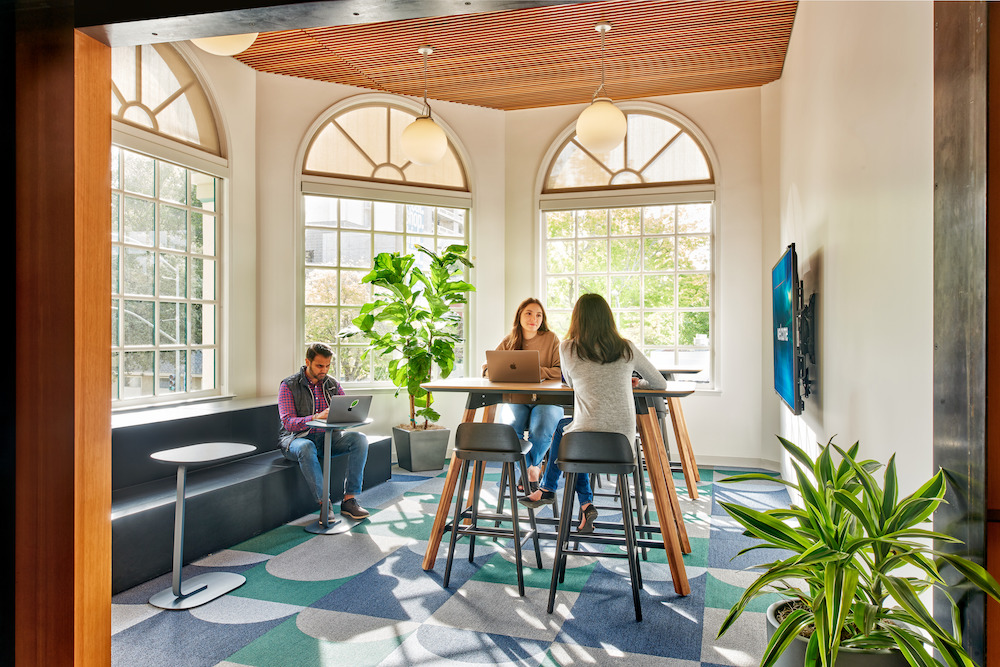Robin Weckesser of a3 Workplace Strategies shares some tips for a customized and strategic approach for the post-pandemic workplace.

Perhaps “normal” is an evolutionary process. As we enter year three and head toward the post-pandemic, several takeaways relative to the workplace are becoming clear. Trends and best practices are emerging and shaping what the future of the workplace looks like.
Workers are starting to think differently about work and the workplace. They are expecting different work environments and models than they did in March 2020. With the benefit of new industry intelligence, corporate real estate executives (CRE’s) have new possibilities to fix what no longer works, align the physical workplace with expectations, and enhance employee engagement and productivity.
The next workplace will be an integration of workers, brand, culture, and technology. The result will be a new, dynamic, experiential space that will become a destination for staff and a motivation for them to return.
One certainty is that COVID-19 has forever changed the workplace. Beyond the mandated safety and health protocols needed now, CRE’s should also recognize they need to think long term. With the stakes increasingly high, they need a strategic plan to prepare for the next crisis.

Emerging Trends
The pandemic has given rise to game-changing trends:
The Great Resignation
According to the Bureau of Labor Statistics, 4.3 million Americans left their jobs in January 2022. The resignation continues with a migration to better positions almost anywhere in our virtual world.
Tight labor market
The search for top talent of course pre-dates the pandemic. But after working from home and knowing they can leverage today’s labor market, employees know they have the upper hand.
Role of women
Under-represented groups have been hit the hardest during the pandemic. The dearth of women in top positions in Corporate America is particularly ironic since so many studies cite why women are such a great asset. Inequities in traditional, male-dominated industries like real estate are especially glaring.
Corporate culture
Compensation and benefits boost retention rates, but an organization’s culture is increasingly important. The physical environment goes a long way in promoting the brand and enhancing the culture. Progressive companies address how employees are engaged and recognized in an environment where they feel they belong.
Return to office/working from home
As of February 2022, 46% of workers had returned to the office, according to Challenger, Gray & Christmas, up from 29.7% at the end of 2021. A recent survey by Robert Half reveals that 71% of Bay Area bosses, for example, want staff back in the office full time. But how do you handle workers who don’t want to return—even to hybrid environments? What incentives can make a difference?
Staggered workplace return
Many employers are still staggering the transition back to the workplace. And most employees continue to be dissatisfied with their jobs and prefer to continue working from home. Throughout the country, the tech giants and smaller corporations are responding to the “post pandemic” world in different ways and are still uncertain about the future. According to a recent survey by Microsoft, 50% of companies are pushing for full in-person occupancy within a year. Workers have other ideas.
Generational issues
At a time when five generations work side by side in the office, the generational rift widens between Baby Boomers and Millennials and Gen Z, which is now the largest generation. Unretirement is the new retirement. After a retirement boom over the last two years, the share of retirees reentering the workforce has ticked up to levels unseen since early March 2020, per The Wall Street Journal. In this eclectic environment, each group has different mindsets and skillsets, and the challenge is to find a common ground.

The Takeaway
Given all these challenges, what is our counsel to decision-makers regarding workplace strategies and solutions in the next normal? Forward-thinking leaders who confront new realities are learning lessons as they examine best practices.
Here’s a checklist for HR and the C-suite:
- Seek feedback from staff about their priorities and needs.
- Assess workplace amenities and see what needs to be upgraded, including wellness programs, breakrooms, cafes, fitness centers, etc.
- Formulate a strategic plan.
- Ensure flexible space options for private offices, open areas, and remote accommodations.
- Be sensitive to DEI (diversity, equality, inclusion), including women in management.
- Be sensitive to the needs of different generations.
- Implement change management programs.
- Provide training and staff development.
- Engage staff to buy in and champion new efforts.
- Adjust corporate culture as needed.
- Partner with an experienced project management consultant.
As the landscape continues to change, we must acknowledge there is no quick fix for the office of the future. But a customized and strategic approach is the prudent way to proceed as we strive to optimize chances for success.

